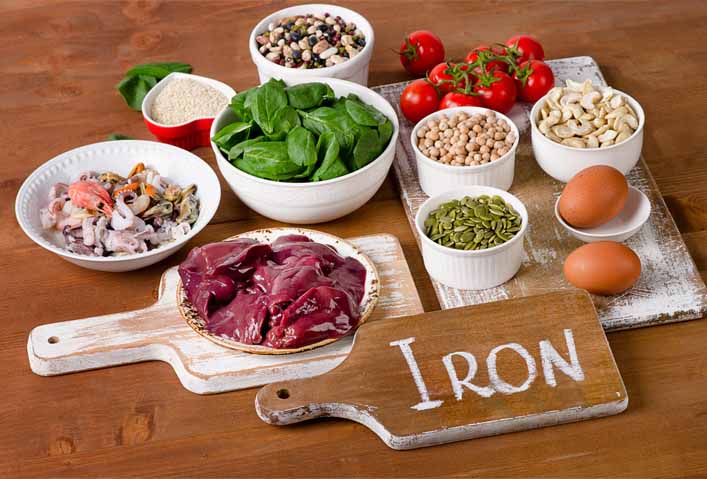Everyone knows that your body needs iron, because without enough of it you can end up sick.
But too much iron can be fatal as well. As with everything in life, trying to get the proper amount of iron in your body is a balancing act.
Iron is considered to be one of the most abundant minerals that is found on the earth. In the human body it has a couple big responsibilities. It is responsible for transporting oxygen to the cells and also for the regulation of cell growth. Around ⅔’s of the iron in the human body is found within the hemoglobin in the blood. Hemoglobin is a protein that is responsible for carrying the oxygen into our body’s tissues. You may have heard the word “hemoglobin” before in hemoglobin a1c. This is a measure of the glucose that attaches to the hemoglobin in the blood.
I suggest reading the following articles:
The remainder of the iron in our body is found within the myoglobin. Myoglobin is another protein that is responsible for delivering the oxygen needed into your muscle tissues, as well as to the proteins that can assist in storing iron for future need.
Too Much Iron in the Body
Iron Deficiency is a problem that affects almost 80% of the population around the world. While many people are familiar with iron deficiency, elevated iron levels in another thing all together.
This is because some evidence has suggested that those who have too much iron increase their risk of developing type 2 diabetes by up to 28%. High iron levels can potentially damage muscle tissue which decreases the body’s ability to efficiently transfer glucose from the blood into the cells in the body.
This can also interfere with the production of insulin. There has also been significant evidence that up to 80% of those who suffer from hemochromatosis, which is a disorder that affects the absorption of iron in the body, eventually develop type 2 diabetes.
Hemochromatosis is a genetic condition in which your body absorbs too much iron. The high levels of iron, then begin to attack the organs in your body, including your beta cells. This increases the risk of developing diabetes, not just type 2.
Those with Celtic ancestry are at a greater risk of developing this condition. Some people absorb so much iron that their skin color changes to a light brown. When they develop diabetes from this, it is often referred to as bronze diabetes due to the color of their skin.
A ferritin test is used to detect the levels of iron in the blood. Ferritin is a protein in which the body uses for iron storage. It’s a great indicator of the levels of iron in your body. Lower levels could mean you are anemic and higher levels could point to hemochromatosis.
Treatment of Hemochromatosis
Hemochromatosis is treatable to help prevent more serious problems such as organ damage or arthritis. Without treatment, the condition will keep storing iron in your body. When the levels become too high, this is when tissue and organ damage can start to happen. It tends to run in families but some people can develop the condition from having a good deal of blood transfusions, liver disease or even alcoholism. The genetic form is referred to as primary hemochromatosis, while the condition through other methods is referred to as secondary hemochromatosis.
Men are more prone to having more iron built up in their body because women of childbearing age typically get rid of any extra iron storage during their menstrual cycles and even during pregnancy.
Symptoms of Hemochromatosis
Symptoms usually are recognizable until age 40 or older. This is due to the time that it takes the excess iron to store up in the body during someone’s lifetime. The symptoms only typically appear once a certain amount of iron has built up.
Early symptoms might be mistaken for something else as they can be vague. Early symptoms can include:
- Joint pain
- Weight Loss
- Frequent urination
- Fatigue
- Weakness
Because hemochromatosis is genetic in nature, if you suffer from the condition, you may want to have your children tested as well. It can be detected early if you are aware of the potential to develop it.
Treatment Options
Treatment for hemochromatosis can include:
Phlebotomy: Considered to be the most common type of treatment, this is done by donating blood on a frequent basis.
Chelation Therapy: This is a type of medicine that can help to rid the body of any excess iron. It can be used as treatment in those who are unable to have phlebotomy done.
Treatment is aimed at removing the excess iron from the blood in a quick and safe manner as well as limiting any progression or complications of the disease. Organ preservation is another important goal for treatment. Many people need to be on treatment for the remainder of their lives, but a small few may not require any further treatment if their blood iron levels return to a more normal level and it is apparent that hemochromatosis is cause by another condition.
Just because the condition runs in families, this doesn’t give you a 100% chance of developing it. This is why checking to find out if you have inherited the gene that causes it can help to put your mind at ease and even start treatment earlier when you are aware of the proper testing.
How Much Iron Daily
Many people already are getting an appropriate daily total just through the meat in their diet. There are some other types of foods that are supplemented with iron as well. You may not know that certain foods and vitamins can hinder or enhance the absorption of iron in the body. Vitamin C has been known to enhance while foods rich in calcium can inhibit the absorption of iron. Daily women of childbearing age should consume only up to 18 mg, postmenopausal women 8mg and men over the age of 18 should also have only 8 mg daily.
Iron Rich Foods:
Iron supplementation is possible for those with lower iron levels, but it is usually best to try to get your daily total through your daily diet. Foods rich in iron include:
- Seafood
- Dark green leafy veggies like kale or spinach
- Peas
- Dried fruits
- Red meat, poultry and pork
- Iron fortified food products like cereal
Further reading:
Conclusion
If you are concerned about higher iron levels or the potential to develop hemochromatosis, speak with your doctor. A simply blood test can help to check your levels or even your genetic link to the development of the condition. So that was the link between iron and diabetes, let us know your thoughts down below.
TheDiabetesCouncil Article | Reviewed by Dr. Sergii Vasyliuk MD on June 01, 2020





